augmenters.pillike¶
Solarize¶
Augmenter with identical outputs to PIL’s solarize() function.
This augmenter inverts all pixel values above a threshold.
The outputs are identical to PIL’s solarize().
API link: Solarize()
Example.
Invert the colors in 50 percent of all images for pixels with a
value between 32 and 128 or more. The threshold is sampled once
per image. The thresholding operation happens per channel.
import imgaug.augmenters as iaa
aug = iaa.Solarize(0.5, threshold=(32, 128))
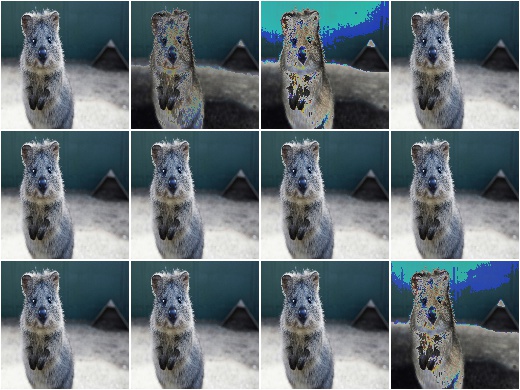
Posterize¶
Augmenter with identical outputs to PIL’s posterize() function.
This augmenter quantizes each array component to N bits.
This class is currently an alias for
Posterize, which again is an alias
for UniformColorQuantizationToNBits,
i.e. all three classes are right now guarantueed to have the same
outputs as PIL’s function.
API link: Posterize()
Equalize¶
Equalize the image histogram.
This augmenter has identical outputs to equalize().
API link: Equalize()
Example. Equalize the histograms of all input images:
import imgaug.augmenters as iaa
aug = iaa.pillike.Equalize()
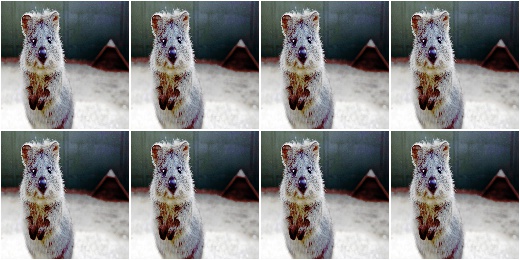
Autocontrast¶
Adjust contrast by cutting off p% of lowest/highest histogram values.
This augmenter has identical outputs to autocontrast().
See autocontrast() for more details.
API link: Autocontrast()
Example.
Modify the contrast of images by cutting off the 0 to 20% lowest
and highest values from the histogram, then stretching it to full length:
import imgaug.augmenters as iaa
aug = iaa.pillike.Autocontrast()
Example.
Modify the contrast of images by cutting off the 10 to 20% lowest
and highest values from the histogram, then stretching it to full length.
The cutoff value is sampled per channel instead of per image.
aug = iaa.pillike.Autocontrast((10, 20), per_channel=True)
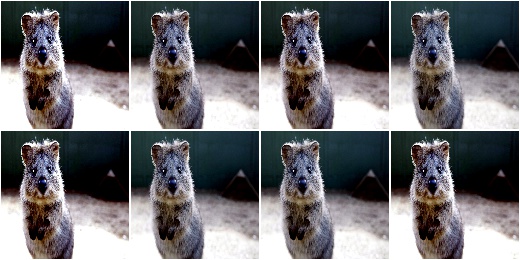
EnhanceColor¶
Convert images to grayscale.
This augmenter has identical outputs to Color.
API link: EnhanceColor()
Example. Create an augmenter to remove a random fraction of color from input images:
import imgaug.augmenters as iaa
aug = iaa.pillike.EnhanceColor()
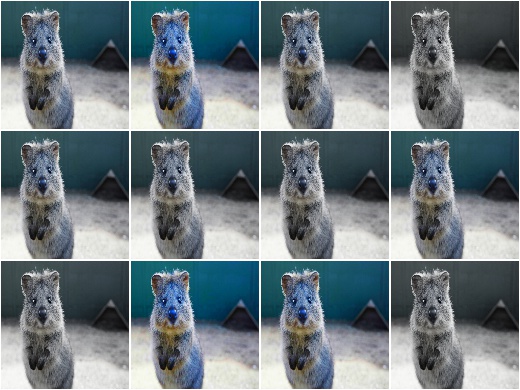
EnhanceContrast¶
Change the contrast of images.
This augmenter has identical outputs to Contrast.
API link: EnhanceContrast()
Example. Create an augmenter that worsens the contrast of an image by a random factor:
import imgaug.augmenters as iaa
aug = iaa.pillike.EnhanceContrast()
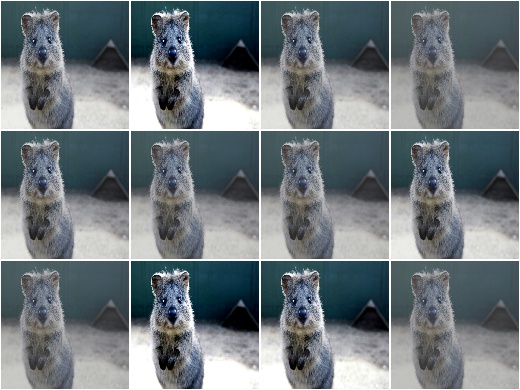
EnhanceBrightness¶
Change the brightness of images.
This augmenter has identical outputs to
Brightness.
API link: EnhanceBrightness()
Example. Create an augmenter that worsens the brightness of an image by a random factor:
import imgaug.augmenters as iaa
aug = iaa.pillike.EnhanceBrightness()
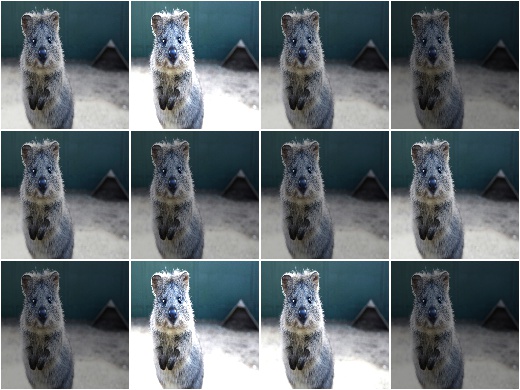
EnhanceSharpness¶
Change the sharpness of images.
This augmenter has identical outputs to
Sharpness.
API link: EnhanceSharpness()
Example. Create an augmenter that randomly decreases or increases the sharpness of an image:
import imgaug.augmenters as iaa
aug = iaa.pillike.EnhanceSharpness()
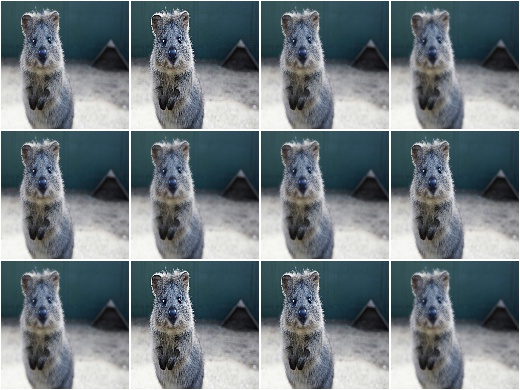
FilterBlur¶
Apply a blur filter kernel to images.
This augmenter has identical outputs to
calling filter() with kernel PIL.ImageFilter.BLUR.
API link: FilterBlur()
Example. Create an augmenter that applies a blur filter kernel to images:
import imgaug.augmenters as iaa
aug = iaa.pillike.FilterBlur()

FilterSmooth¶
Apply a smoothening filter kernel to images.
This augmenter has identical outputs to
calling filter() with kernel PIL.ImageFilter.SMOOTH.
API link: FilterSmooth()
Example. Create an augmenter that applies a smoothening filter kernel to images:
import imgaug.augmenters as iaa
aug = iaa.pillike.FilterSmooth()

FilterSmoothMore¶
Apply a strong smoothening filter kernel to images.
This augmenter has identical outputs to
calling filter() with kernel PIL.ImageFilter.BLUR.
API link: FilterSmoothMore()
Example. Create an augmenter that applies a strong smoothening filter kernel to images:
import imgaug.augmenters as iaa
aug = iaa.pillike.FilterSmoothMore()

FilterEdgeEnhance¶
Apply an edge enhance filter kernel to images.
This augmenter has identical outputs to
calling filter() with kernel
PIL.ImageFilter.EDGE_ENHANCE.
API link: FilterEdgeEnhance()
Example. Create an augmenter that applies a edge enhancement filter kernel to images:
import imgaug.augmenters as iaa
aug = iaa.pillike.FilterEdgeEnhance()

FilterEdgeEnhanceMore¶
Apply a strong edge enhancement filter kernel to images.
This augmenter has identical outputs to
calling filter() with kernel
PIL.ImageFilter.EDGE_ENHANCE_MORE.
API link: FilterEdgeEnhanceMore()
Example. Create an augmenter that applies a strong edge enhancement filter kernel to images:
import imgaug.augmenters as iaa
aug = iaa.pillike.FilterEdgeEnhanceMore()

FilterFindEdges¶
Apply a edge detection kernel to images.
This augmenter has identical outputs to
calling filter() with kernel
PIL.ImageFilter.FIND_EDGES.
API link: FilterFindEdges()
Example. Create an augmenter that applies an edge detection filter kernel to images:
import imgaug.augmenters as iaa
aug = iaa.pillike.FilterFindEdges()

FilterContour¶
Apply a contour detection filter kernel to images.
This augmenter has identical outputs to
calling filter() with kernel PIL.ImageFilter.CONTOUR.
API link: FilterContour()
Example. Create an augmenter that applies a contour detection filter kernel to images:
import imgaug.augmenters as iaa
aug = iaa.pillike.FilterContour()

FilterEmboss¶
Apply an emboss filter kernel to images.
This augmenter has identical outputs to
calling filter() with kernel PIL.ImageFilter.EMBOSS.
API link: FilterEmboss()
Example. Create an augmenter that applies an emboss filter kernel to images:
import imgaug.augmenters as iaa
aug = iaa.pillike.FilterEmboss()

FilterSharpen¶
Apply a sharpening filter kernel to images.
This augmenter has identical outputs to
calling filter() with kernel PIL.ImageFilter.SHARPEN.
API link: FilterSharpen()
Example. Create an augmenter that applies a sharpening filter kernel to images:
import imgaug.augmenters as iaa
aug = iaa.pillike.FilterSharpen()

FilterDetail¶
Apply a detail enhancement filter kernel to images.
This augmenter has identical outputs to
calling filter() with kernel PIL.ImageFilter.DETAIL.
API link: FilterDetail()
Example. Create an augmenter that applies a detail enhancement filter kernel to images:
import imgaug.augmenters as iaa
aug = iaa.pillike.FilterDetail()

Affine¶
Apply PIL-like affine transformations to images.
This augmenter has identical outputs to
transform() with parameter method=PIL.Image.AFFINE.
Note
This augmenter can currently only transform image-data.
Batches containing heatmaps, segmentation maps and
coordinate-based augmentables will be rejected with an error.
Use Affine if you have to
transform such inputs.
Note
This augmenter uses the image center as the transformation center.
This has to be explicitly enforced in PIL using corresponding
translation matrices. Without such translation, PIL uses the image
top left corner as the transformation center. To mirror that
behaviour, use center=(0.0, 0.0).
API link: Affine()
Example. Create an augmenter that applies affine scaling (zoom in/out) to images. Along the x-axis they are scaled to 80-120% of their size, along the y-axis to 50-150% (both values randomly and uniformly chosen per image).
import imgaug.augmenters as iaa
aug = iaa.pillike.Affine(scale={"x": (0.8, 1.2), "y": (0.5, 1.5)})

Example.
Create an augmenter that translates images along the y-axis by either
-10px or 10px. Newly created pixels are always filled with
the value 128 (along all channels).
aug = iaa.pillike.Affine(translate_px={"x": 0, "y": [-10, 10]},
fillcolor=128)
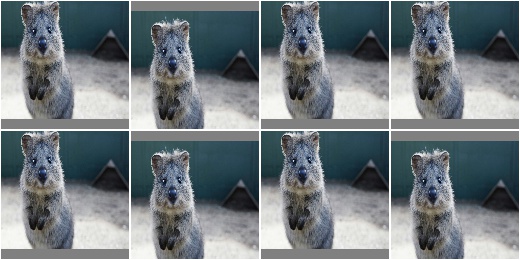
Example.
Rotate an image by -20 to 20 degress and fill up all newly
created pixels with a random RGB color:
aug = iaa.pillike.Affine(rotate=(-20, 20), fillcolor=(0, 256))
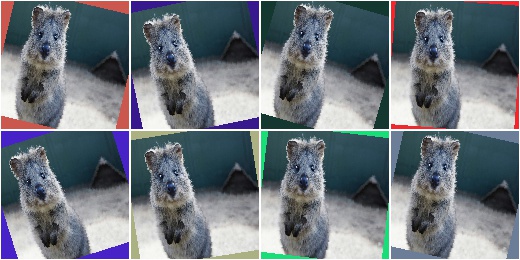
See the similar augmenter Affine
for more examples.